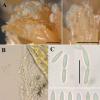
16-01-2026 00:45
Ethan CrensonHi all, On decorticated hardwood from a New York

18-01-2026 12:24
Hello.An anamorph located on the surface of a thin

17-01-2026 19:35
Arnold BüschlenHallo, ich suche zu Cosmospora aurantiicola Lite

08-12-2025 17:37
 Lothar Krieglsteiner
Lothar Krieglsteiner
20.6.25, on branch of Abies infected and thickened

10-01-2026 20:00
Tom SchrierHi all,We found picnidia on Protoparmeliopsis mur

13-01-2026 07:28
 Danny Newman
Danny Newman
Chlorociboria glauca on indet. decorticate logThe

15-01-2026 15:55
 Lothar Krieglsteiner
Lothar Krieglsteiner
this one is especially interesting for me because
Myrothecium causing Sphagnum infection
Nina Filippova,
25-10-2014 17:28
There are not may pathogens of Sphagnum species and therefore it is interesting to find the signs of Sphagnum damage caused by fungal infection. I have found one anamorphic species in my collection which was not recognized before, and i hoping now that it could be assigned at least to its generic position.
Preliminary it was identified as Myrothecium cf. roridum. This taxon is reported from different plant litters and as parasitic on some hosts (but not on Sphagnum) by Domsch (2007). Still, it is common soil saprotroph, and was reported by some authors from peat in peatlands.
12.07.2013, Khanty-Mansiysk town, Western Siberia; 60,89263N 68,67715E
Graminoid-Sphagnum hollows in ombrotrophic bog, on living plats of Sphagnum balticum, S. jensenii, seems parasitizing on these plants. The fungus caused infectious spots 10 and more cm in diameter where Sphagnum looked faded. Such infectious spots were quite regularly met in this year (e.g. not rare event) and the attacked Sphagnum was not weakened by any damage (in natural undisturbed conditions).
Conidiogenous cells bottle-shaped, 4-5 in cluster, mean size 17 x 3 mk; conidia fusoid (upper) to cylindrical (lower in chain), hyaline, in chains, connected by thin constriction, with hyaline appendages, 5.7 (5.1–7.3) x 1.8 (1.5–2) mk (n=13).
Could you direct me to the close morphologically genera and species there could be? I could not find also the key (Tulloch, M. Genus Myrothecium Tode ex FR Mycol. Pap. 130. 1972).
There are some not very detailed photos below. Nina.
Walter Gams,
25-10-2014 17:47
Re : Myrothecium causing Sphagnum infection
Dear Nina, You may ssend me a culture to my home address at Molenweg 15, 3743 CK Baarn, Netherlands. I shall look at it microscopically and deposit the strain at CBS, where a molecular analysis will be made. But this may take several weeks.
Best wishes Walter Gams
Best wishes Walter Gams
Nina Filippova,
25-10-2014 17:52
Re : Myrothecium causing Sphagnum infection
Thanks Walter, i will answer you in private.


